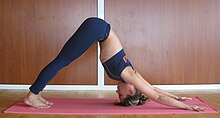Standing asanas
The standing asanas are the yoga poses or
The origin of standing asanas has been controversial since
Context

In hatha yoga
Among the few standing poses definitely practised in

Some other standing poses have been suspected of having medieval origins, without reliable evidence. One difficulty is naming; the existence of a medieval pose with the name of a current standing pose is not proof that the two are the same, as the names given to poses may change, and the same name may be used for different poses. For example, the name Garudasana, Eagle Pose, is used for a sitting pose in the Gheraṇḍa Saṃhitā, 2.37.[4] The name Garudasana is given to a pose close to Vrikshasana in the 19th century Sritattvanidhi; the modern standing pose named Garudasana is not seen until the 20th century.[6][7]
Another issue is the use that is made of a pose; the existence of a pose in medieval times is not proof that it was used in hatha yoga. For example,
Another case is Utkatasana, sometimes called chair pose, though its name, Utkata, means "fierce". In modern yoga, it is indeed a challenging squatting pose with the thighs approaching the horizontal,[9] whereas in the 19th century Sritattvanidhi it is illustrated as a low squatting pose with the buttocks resting against the heels; the Gheraṇḍa Saṃhitā 2.27 is similar, but the heels are raised.[10]
In yoga as exercise
Standing asanas such as

In 1924,
The origin of standing asanas has been controversial[24][25] since Singleton's 2010 book Yoga Body argued that some forms of modern yoga represent a radical reworking of hatha yoga, in particular by adding standing asanas and transitions (vinyasas) between them, and by suppressing most non-postural aspects of yoga, rather than a smooth continuation of ancient traditions. The addition of vinyasas enabled sequences consisting mainly of standing asanas to be practised in a continuous flow. Such a sequence could be performed quickly if desired, making for aerobic exercise, possibly at the expense of a more meditative practice.[26]
| Asana | English | Described by | Date | Image |
|---|---|---|---|---|
Vrikshasana |
Tree pose[27] | Gheraṇḍa Saṃhitā[4] |
17th C.[4] |  |
| Garudasana | Eagle pose[28] | Sritattvanidhi[6] | 19th C.[6] |  |
Parsvakonasana |
Side angle pose[29] | Light on Yoga[29][b] | 20th C.[29] |  |
| Trikonasana | Triangle pose[30] | Light on Yoga[30][b] | 20th C.[30] |  |
| Utkatasana | Chair pose[31] | Light on Yoga[31][b] | 20th C.[31] |  |
Ardha Chandrasana |
Half moon pose[32] | Light on Yoga[32][b] | 20th C.[32] |  |
Viparita Virabhadrasana |
Reversed warrior pose[33] | Yoga Journal[33] | 21st C.[33] |  |
Surya Namaskar
Surya Namaskar is a major source of standing asanas. In its modern form, it was created and popularised by the
Surya Namaskar was not recorded in any Haṭha yoga text before the 19th century.
Notes
References
- ^ a b Krucoff, Carol (28 August 2007). "Find Your Roots in Tree Pose". Yoga Journal.
- ^ Monier-Williams, Monier, "Yoga", A Sanskrit Dictionary, 1899.
- ^ Mallinson 2011, pp. 770–772.
- ^ a b c d Rai Bahadur Srisa Chandra Vasu (translator) Gheraṇḍa Saṃhitā
- ^ OCLC 926062252.
- ^ a b c Sjoman 1999, pp. 75 and plate 7, pose 39.
- ^ Iyengar 1991, pp. 97–98.
- ^ Bhavanani, Ananda Balayogi; Bhavanani, Devasena (2001). "Bharatanatyam and Yoga". Archived from the original on 23 October 2006.
- ^ "Chair | Utkatasana". Yoga Basics. Retrieved 18 January 2019.
- ^ Sjoman 1999, pp. 83, plate 17.
- ^ Iyengar 1991, pp. 61–84.
- ^ Sjoman 1999, pp. 49, 54–55, 100–101.
- ^ Anon (28 August 2007). "Downward-Facing Dog". Yoga Journal. Retrieved 13 July 2019.
- ^ Wathen, Grace (1 July 2011). "Kaivalyadhama & Yoga Postures". LiveStrong. Archived from the original on 12 November 2011.
- ^ Alter 2004, p. 31.
- ^ Singleton, Mark (12 February 2011). "Not as Old as You Think". OPEN Magazine. Retrieved 27 April 2020.
- ^ Mohan, A. G.; Mohan, Ganesh (29 November 2009). "Memories of a Master". Yoga Journal. Retrieved 27 April 2020.
- ^ Anderson, Diane (9 August 2010). "The YJ Interview: Partners in Peace". Yoga Journal. Retrieved 27 April 2020.
- ^ Singleton, Mark (4 February 2011). "The Ancient & Modern Roots of Yoga". Yoga Journal. Retrieved 27 April 2020.
- ^ Bharadwaj 1896.
- ^ Sjoman 1999, pp. 54–55.
- ^ a b Sjoman 1999, p. 49.
- ^ Bukh 2010.
- ^ Singleton 2010, p. 15.
- ^ Remski, Matthew. "Mark Singleton Responds to Critics Who Didn't Want to Understand His Book". Matthew Remski. Retrieved 16 February 2019.
- ^ Singleton 2010, pp. 175–210, and whole book.
- ^ Iyengar 1991, p. 62.
- ^ Iyengar 1991, p. 97.
- ^ a b c Iyengar 1991, p. 66.
- ^ a b c Iyengar 1991, p. 63.
- ^ a b c Iyengar 1991, p. 88.
- ^ a b c Iyengar 1991, p. 74.
- ^ a b c McCrary, Meagan (15 July 2015). "#YJ40: 10 Poses Younger Than Yoga Journal". Yoga Journal.
Reverse Warrior You won't find this playful variation of Warrior II Pose in Light on Yoga.
- ^ a b Singleton 2010, p. 124.
- ISBN 978-0-8122-3556-2.
- OCLC 1017424915.
- ^ Alter 2004, p. 23.
- ^ Mehta 1990, pp. 146–147.
- ^ "Surya Namaskar Variations: How it is done in these 3 popular yoga traditions". The Times of India. 23 June 2018. Retrieved 14 April 2019.
Sources
- OCLC 53483558.
- Bharadwaj, S. (1896). Vyayama Dipika, Elements of Gymnastic Exercises, Indian System. Caxton Press. (no OCLC)
- ISBN 978-1446527351.
- OCLC 51315708.
- ISBN 978-90-04-27128-9.
- Mehta, Silva; Mehta, Mira; Mehta, Shyam (1990). ISBN 978-0863184208.)
{{cite book}}: CS1 maint: multiple names: authors list (link - OCLC 318191988.
- ISBN 81-7017-389-2.
External links
- Standing Poses (29 images) by Witold Fitz-Simon


